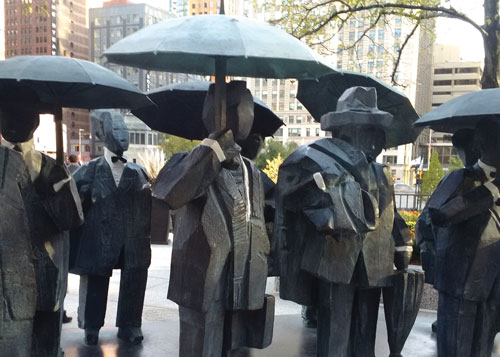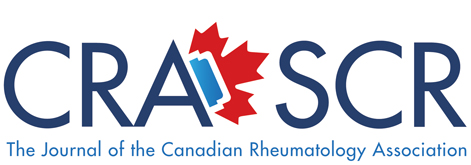Winter (Volume 28, Number 4)
ACR 2018 Report
By Philip A. Baer, MDCM, FRCPC, FACR
Download PDF
The ACR returned to Chicago this year after a seven-year
absence. Apparently, Chicago is named the
Windy City based on the hot air generated by its politicians
in the past. This year it was windy in the weather
sense as well, with flight turbulence en-route and flying debris
while walking on the Magnificent Mile and near Lake
Michigan being commonly noted.
The meeting was at the spacious McCormick Place south
of downtown, with excellent access via Chicago Transit Authority
(CTA) trains and the American College of Rheumatology
(ACR) Shuttle. Canadians were well represented at
the opening awards ceremonies, with Earl Silverman being
recognized as an ACR Master, and Dafna Gladman picking
up yet another award, this time as ACR Distinguished Clinical
Investigator. Interestingly, of the 21 new ACR Masters,
only one was listed as retired, despite the age 65+ requirement
to be a Master. Looks like rheumatologists really love
their work!

Sculpture at McCormick Square: Are those joints arthritic?

Famous Tiffany dome ceiling at Macy's State Street store.
I had no posters to present, so much more freedom to wander
through the meeting sessions. Congratulations to Ines
Colmegna and Vinod Chandran who each presented at the
podium during an ACR Plenary Session. Dr. Colmegna’s work
with her group at McGill was also highlighted at an ACR
press conference. Her abstract #837 highlighted the improved
immune response noted in seropositive rheumatoid arthritis (RA) patients immunized with a high-dose trivalent
influenza vaccine versus a standard-dose quadrivalent vaccine.
Good to know as the flu season approaches. Dr. Chandran’s
abstract #2787 showed that -21 HLA-Class I Dimorphism
differentiates psoriatic arthritis (PsA) from psoriasis
without psoriatic arthritis (PsC). PsC patients within their
discovery cohort and replication study had a significantly
lower prevalence of -21M compared to controls, as well as
those with PsA.
This study provides indications for a potential role of
natural killer (NK) cells in PsA pathogenesis, as well as providing
a genetic marker that differentiates PsA from PsC. I
will have to stop abbreviating psoriasis as PsO if PsC is the
correct term.
The ACR Year in Review session kicked the meeting off
with all kinds of interesting material: A human skeletal stem
cell has been recently identified. Somewhat ignored cells
such as fibroblasts and stromal cells may have important
pathogenetic roles in our rheumatic diseases. Platelets can
donate sugars to glycosylate antibodies. On the clinical side,
no bleeding was encountered in 1,050 joint aspirations/injections done at the Mayo Clinic on patients taking direct-acting oral anti-coagulants (DOACs)/novel oral anti-coagulants
(NOACs). Opioids were no better than non-opioids
regarding function and pain interference in patients with
hip and knee OA or chronic low back pain, but performed
worse regarding pain intensity reductions. Apparently, there is a DREAM study as well as a DREAM registry: the DREAM
study showed oral fatty acids were ineffective for dry eyes
in Sjogren’s syndrome. Mortality in systemic lupus erythematosus
(SLE) is declining, but not as rapidly as mortality
in non-SLE populations. The ARTIS registry concluded that,
overall, TNF inhibitors do not increase the risk of recurrent
cancer in RA.
The meeting highlighted many papers on Janus kinase
(JAK) inhibitors, cardiovascular disease in RA, and real-
world evidence on the effectiveness and safety of many
familiar therapies. Patient-related outcomes and biosimilars
continue to be topical, as well as immune-related adverse
events to checkpoint inhibitors used in oncology. New ACR
and ACR/EULAR guidelines and criteria were presented on
reproductive health in rheumatology patients, large-vessel
vasculitis and IgG-4 related disease.

JAKs were everywhere at ACR 2018.
I really enjoyed The Great Debate on monitoring for
retinal toxicity in patients on hydroxychloroquine (HCQ).
Both debaters, Dr. James Rosenbaum (the only rheumatologist
who heads a Department of Ophthalmology) and
Dr. Michelle Petri (passionate lupologist at Hopkins), did
an excellent job. I think Dr. Petri won, based on her argument
that HCQ toxicity is low, manageable, and reversible
if caught early, and that the documented efficacy of HCQ
in preventing morbidity and mortality in SLE must not be
compromised.
Dr. John O’Shea, the key scientist who led the development
of jakinibs, gave an excellent overview of the field.
With four JAKs handling 57 cytokines (including growth
hormone and leptin), the science can be quite confusing.
He reviewed all the agents and clinical trials, as well
as issues in assessing selectivity. New formulations could
include inhaled, topical and non-absorbable jakinibs. He
also covered oclacitinib, a jakinib only approved in dogs for
atopic dermatitis, which I encountered recently when reviewing
the medications of a canine member of our extended
family (the drug brand name is Apoquel, which sounded
to me like a generic version of Seroquel, but I was wrong).

The Gentlemen Statues near the Chicago River downtown.
Overall, this year's meeting was very well-attended, with
15,000 attendees, of which 12,000 were scientific attendees.
A total of 3,032 abstracts were accepted with 106
countries represented.
All in all, another successful and jam-packed meeting,
which still allowed time to enjoy all that Chicago has to offer
in terms of architecture, shopping and restaurants. Next
year we will be in Atlanta for ACR 2019.
Philip A. Baer, MDCM, FRCPC, FACR
Editor-in-chief, CRAJ
Scarborough, Ontario

The future of healthcare: Vision for 2030.
|
